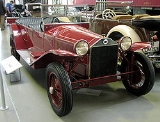
Lancia Lambda
Encyclopedia
The Lancia Lambda is an innovative automobile
produced from 1922 through 1931. It was the first car to feature a load-bearing monocoque
-type body, (but without a stressed roof) and it also pioneered the use of an independent suspension
(the front sliding pillar
with coil spring
s). Vincenzo Lancia even invented a shock absorber
for the car and it had excellent four wheel brakes. Approximately 11,200 Lambdas were produced.
Nine versions of the Lambda were built:
was also notable. All three displacements shared the same long 120 mm (4.7 in) stroke, and all were SOHC designs with a single camshaft serving both banks of cylinders. First engine had 13° V angle, second 14° and 3rd 13° 40'.
Automobile
An automobile, autocar, motor car or car is a wheeled motor vehicle used for transporting passengers, which also carries its own engine or motor...
produced from 1922 through 1931. It was the first car to feature a load-bearing monocoque
Monocoque
Monocoque is a construction technique that supports structural load by using an object's external skin, as opposed to using an internal frame or truss that is then covered with a non-load-bearing skin or coachwork...
-type body, (but without a stressed roof) and it also pioneered the use of an independent suspension
Independent suspension
Independent suspension is a broad term for any automobile suspension system that allows each wheel on the same axle to move vertically independently of each other. This is contrasted with a beam axle, live axle or deDion axle system in which the wheels are linked – movement on one side affects...
(the front sliding pillar
Sliding pillar
A sliding pillar suspension is a form of independent front suspension for light cars. The stub axle and wheel assembly are attached to a vertical pillar or kingpin which slides up and down through a bush or bushes which are attached to the vehicle chassis, usually as part of transverse outrigger...
with coil spring
Coil spring
A Coil spring, also known as a helical spring, is a mechanical device, which is typically used to store energy and subsequently release it, to absorb shock, or to maintain a force between contacting surfaces...
s). Vincenzo Lancia even invented a shock absorber
Shock absorber
A shock absorber is a mechanical device designed to smooth out or damp shock impulse, and dissipate kinetic energy. It is a type of dashpot.-Nomenclature:...
for the car and it had excellent four wheel brakes. Approximately 11,200 Lambdas were produced.
Nine versions of the Lambda were built:
- 1st series, produced 1923, 400 built.
- 2nd series, produced between 1923 and 1924, 1,100 built. Minor modifications for engine.
- 3rd series, produced 1924, 800 built. Engine modified.
- 4th series, produced between 1924 and 1925, 850 built. Modified windscreen.
- 5th series, produced 1925, 1,050 built. 4-speed gearbox.
- 6th series, produced between 1925 and 1926, 1,300 built. Car is sold now with bare chassis and with two wheelbases.
- 7th series, produced between 1926 and 1928, 3,100 built. New bigger engine.
- 8th series, produced between 1928 and 1930, 3,903 built. Again bigger engine.
- 9th series, produced 1931, 500 built. Last series sold only bare chassis.
Engines
The narrow-angle aluminum Lancia V4 engineLancia V4 engine
Lancia pioneered the V engine design, producing the first V6 as well as the first V4s. Several different V4 families were produced from the 1920s through 1960s.-Lambda:...
was also notable. All three displacements shared the same long 120 mm (4.7 in) stroke, and all were SOHC designs with a single camshaft serving both banks of cylinders. First engine had 13° V angle, second 14° and 3rd 13° 40'.
| Model | Engine | Displacement | Power | Fuel system |
|---|---|---|---|---|
| S.1-S.6 | V4 V4 engine A V4 engine is a V form engine with four cylinders and three main bearings.-Automobile use:Lancia produced several narrow-angle V4 engines from the 1920s through 1960s for cars like the Lambda, Augusta, Artena, Aprilia, Ardea, Appia, and Fulvia.... SOHC |
2121 cc | 49 hp (36.5 kW) @ 3250 rpm | single carburetor |
| S.7 | V4 SOHC | 2375 cc | 59 hp (44 kW) @ 3250 rpm | single carburetor |
| S.8-S.9 | V4 SOHC | 2569 cc | 69 hp (51.5 kW) @ 3500 rpm | single carburetor |

